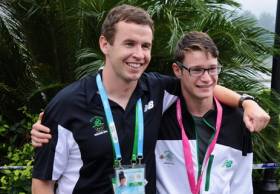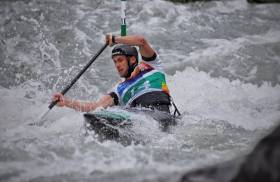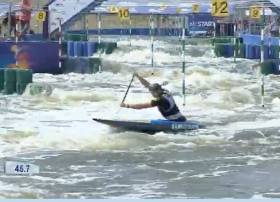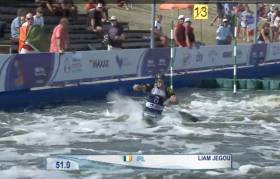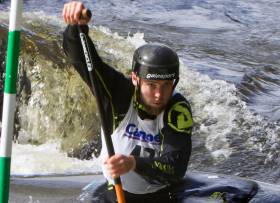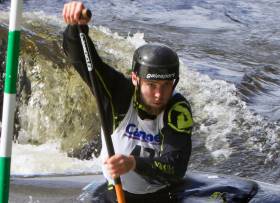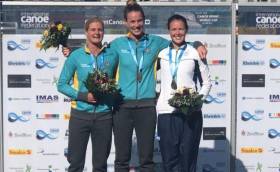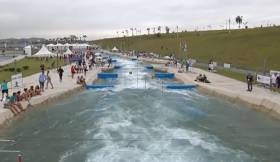Displaying items by tag: Liam Jegou
Jegou Places Well in Irish Selection Races at British Open
#Canoeing: Liam Jegou shone in the Irish Selection Races at the canoe slalom British Open at Lee Valley. The 23-year-old paddler was the fastest C1 competitor in the two runs on Saturday and again on Sunday. On the two Sunday runs, Robert Hendrick, who qualified the C1 for Tokyo, had a 50 second penalty for missing gate 12 in the first run and gate five in the second.
The races were part of the process of choosing the Ireland C1 paddler for Tokyo. There is an appeals window, and an announcement of the nominee will not be made until later.
Hendrick Qualifies for World Championship Semi-Finals
#Canoeing: Robert Hendrick qualified for the semi-final of the C1 (Canadian canoe) at the canoe slalom World Championships at La Seu d’Urgell today.
The Kildare man took 10th place in his second run – just inside the crucial cut-off point. Hendrick’s 99.03 seconds with no time penalties put him in 11th in the first set of results, but Italy’s Roberto Colazingari was then given a 50-second penalty for missing a gate and dropped out of the top 10. Hendrick had made it through.
Hendrick will qualify Ireland for a place in the C1 in Tokyo 2020 if he can place in the top 11 nations in the semi-finals.
Liam Jegou finished 13th, missing out on a qualification spot because of a two-second penalty for a touch on gate 11. Jake Cochrane, who was less than half a second outside qualification in the first run, did not do so well second time around and finished 49th. He missed gate five and incurred a 50-second penalty.
Canoe Slalom World Championships, La Seu d’Urgell, Spain (Irish interest)
Men
C1 – First Run (top 20 qualify directly): 26 J Cochrane 99.72, 38 R Hendrick 103.68, 46 L Jegou 106.38. SECOND RUN (top 10 to semi-finals): 10 Hendrick 99.03; 13 Jegou 99.62, 49 Cochrane 151.72
Women
K1 – First Run (top 20 qualify directly): 72 H Craig 182.68, 75 A Conlan 195.02, 76 C O’Ferrall 245.62. SECOND RUN (top 10 to semi-finals): 41 Conlan 133.13, 45 O’Ferrall 148.39, 51 Craig 174.61
Cochrane Close after First World Championship Run
#Canoeing: The first run in the men’s C1 at the canoe slalom World Championships saw Jake Cochrane come closest to qualifying for the semi-finals. Cochrane had a fast, clear run to the final gate at La Seu d’Urgell, and even a touch here still left him in the hunt for a top 20 place. His time of 99.72 eventually placed him 26th. Robert Hendrick also had just one touch – on gate 20 – and finished 38th on this run.
Liam Jegou had a disapointing run, touching four gates and placing 46th.
The second run comes later today.
Canoe Slalom World Championships, La Seu d’Urgell, Spain (Irish interest)
Men
C1 – First Run (top 20 qualify directly): 26 J Cochrane 99.72, 38 R Hendrick 103.68, 46 L Jegou 106.38.
#Canoeing: Ireland’s Liam Jegou took bronze at the canoe slalom World Championships in Krakow, Poland.
Liam Jegou looked well on course in the final of the C1 – only to touch gate 14. This pushed him out of gold medal place, but his raw time was so good that he finished third behind two France paddlers, Nicolas Gestin and Lucas Roisin.
Canoe Slalom Under-23 World Championships, Krakow (Irish interest)
Men, C1 Semi-Final: 4 L Jegou 93.79
Final: 3 Jegou 91.97.
#Canoeing: Liam Jegou eased into the final of the men’s C1 at the canoe slalom World Championships this morning. The Ireland paddler delivered a fault-free semi-final in 93.79 seconds to place fourth of the 10 finalists.
Canoe Slalom Under-23 World Championships, Krakow (Irish interest)
Men, C1 Semi-Final: 4 L Jegou 93.79
#Canoeing: Ireland will have three paddlers in the semi-finals of under-23 events at the canoe slalom World Under-23 and Junior Championships at Krakow in Poland. Liam Jegou finished 10th on his first run in the C1, though he made a mistake on gate nine and had to go at it a second time. Noel Hendrick and Eoin Teague also qualified from their first runs in the K1.
Canoe Slalom World U23 and Junior Championships, Krakow, Poland (Irish interest; qualifiers)
Men
Under-23 C1, First Run: 10 L Jegou 100.89.
K1, First Run: 12 N Hendrick 96.08; 25 E Teague 99.15.
Ireland Paddler Jegou Four Places off Final at World Cup
#Canoeing: Liam Jegou put in a solid performance at the canoe slalom World Cup in Lee Valley today. The Ireland C1 paddler had a fault-free run and took 14th of the 30 competitors in the semi-final, missing out on a top-10 place by 2.4 seconds. His placing put him 10th of the competing nations – the top 11 nations at the World Championships in September will qualify a boat for the Olympic Games.
Canoe Slalom World Cup, Lee Valley, London (Irish interest)
Men
C1 – Semi-Final (First 10 to Final): 14 Ireland (L Jegou) 101.15 seconds.
Jegou Takes Place in Semi-Final at Lee Valley World Cup
#Canoeing: Liam Jegou qualified for the semi-finals of the canoe slalom World Cup in Lee Valley in London today. He took ninth place in the second run, and will go off second of the 30 C1 competitors in the semi-finals on Saturday. The top 10 go through to the final.
Bronze for Jenny Egan at Duisburg World Cup
#Rowing: Jenny Egan had another podium finish at the canoe sprint World Cup today. Following a silver in Poznan last weekend, she took a bronze in Duisburg in her favourite event, the K1 5,000m. Two Australians took gold and silver. Ronan Foley was 15th in the men’s 5,000. Barry Watkins took sixth in the C Final of the men’s K1 1,000 and sixth in the B Final of the K1 500.
In other canoeing news, Matthew McCartney took bronze at junior level at the canoe marathon World Cup in Norway in two events: the K1 22.6 kilometre and the K1 3,400m.
Liam Jegou reached the final of the C1 at the canoe slalom European Championships in Pau, but missed out on the final.
Jegou Takes His Bow in World Championship Semi-Final
#Canoeing: Ireland’s Liam Jegou finished 24th in the semi-final of the canoe slalom World Championships in Rio de Janeiro. The C1 paddler incurred four seconds of penalties for touches on gate one and gate 10 which cost him his chance of making the top 10 and Saturday’s final.
Canoe Slalom World Championships, Rio de Janeiro: C1 Semi-Final (First 10 to A Final): 24 Ireland (L Jegou) 110.04 seconds.


























